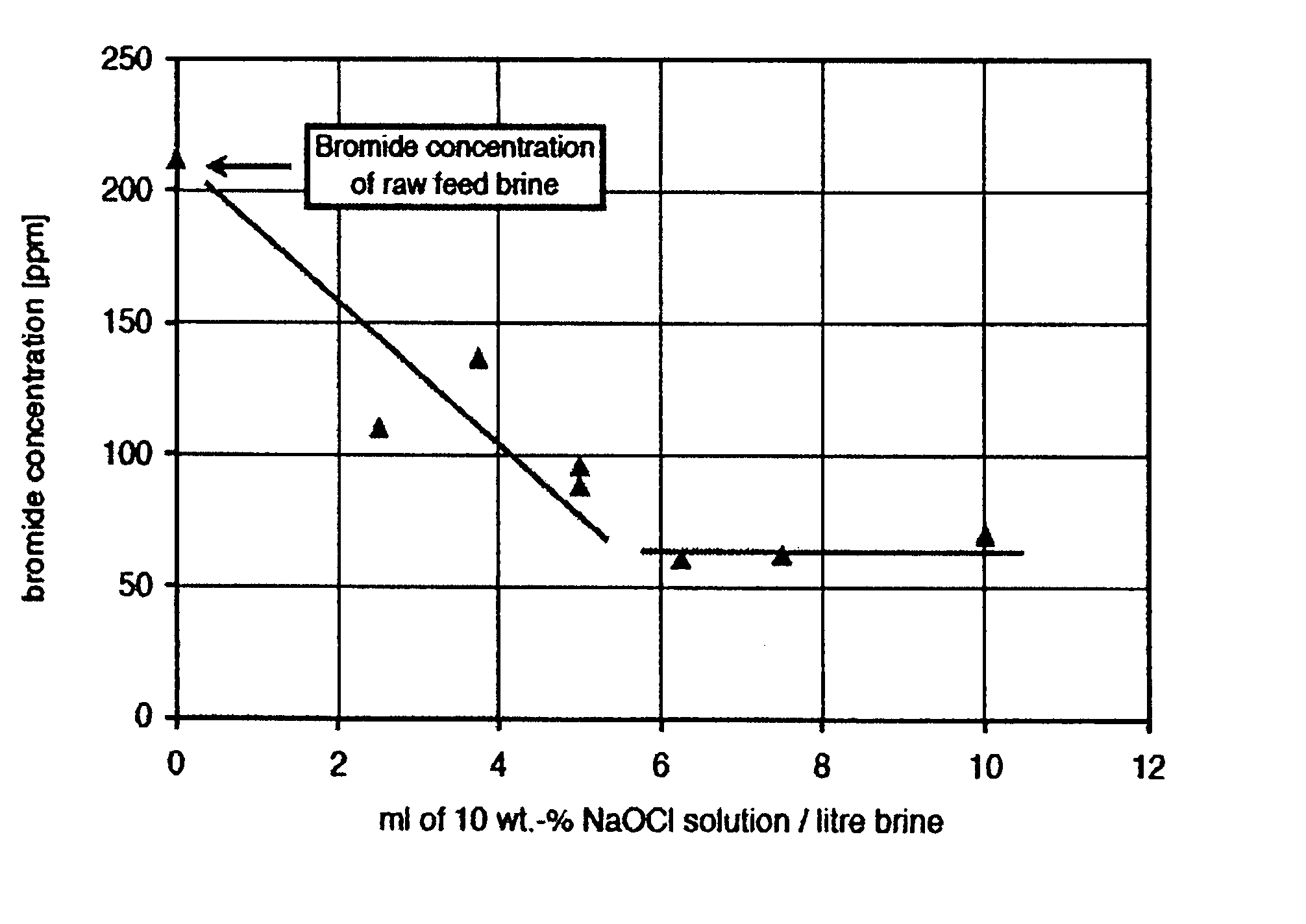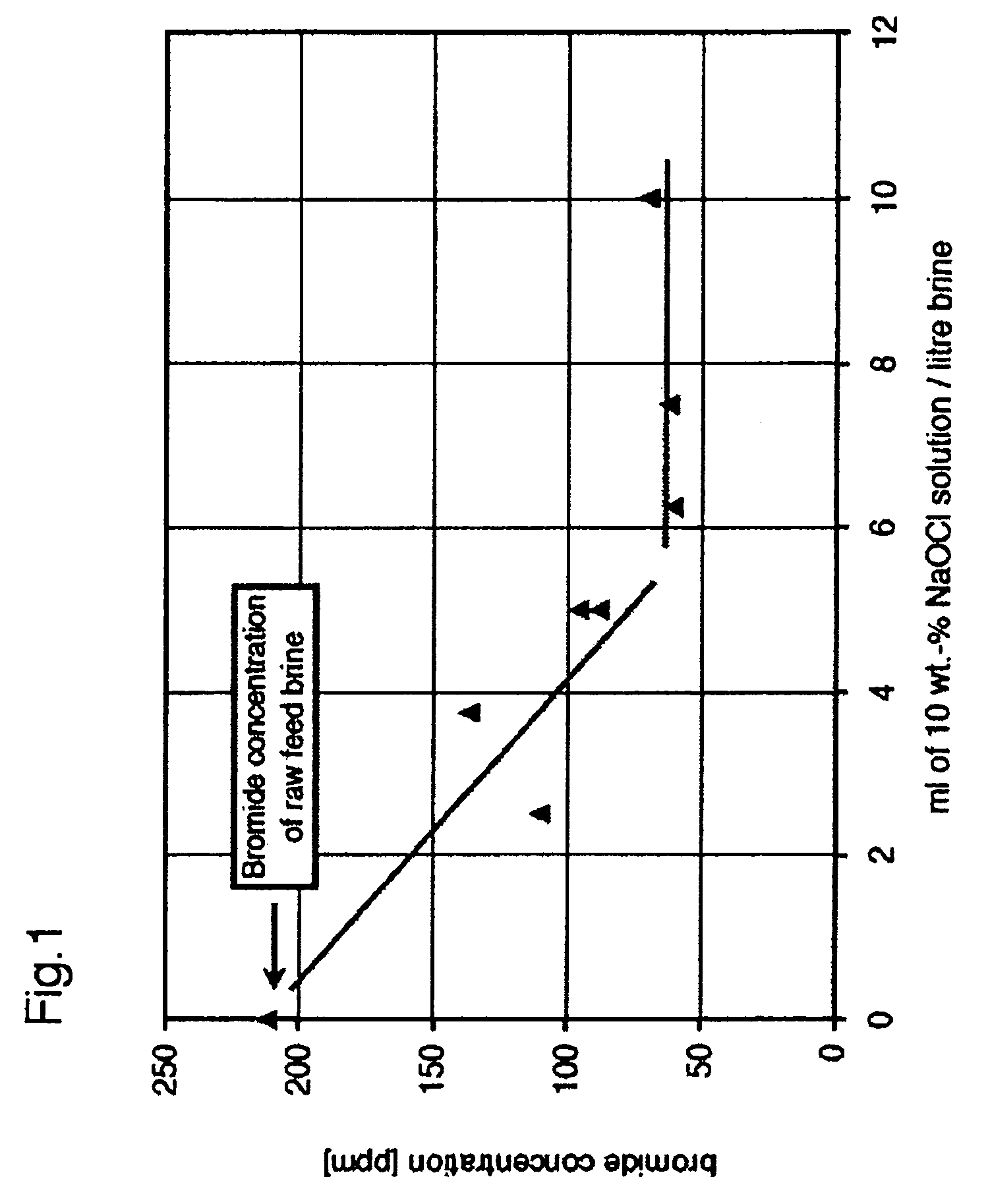Bromide reduction process in liquid solutions
a technology of liquid solution and bromide, which is applied in the field of brine processing, can solve the problems of unsuitable potash for certain applications, difficult to remove bromide in products, and the effectiveness of the technique in removing some other unwanted soluble components such as bromide is less effective, so as to reduce the effective removal of bromide and reduce the ph. , the effect of adding to the cost of production
- Summary
- Abstract
- Description
- Claims
- Application Information
AI Technical Summary
Benefits of technology
Problems solved by technology
Method used
Image
Examples
example 1
Raw Feed Brine
[0039] Initial bromide levels in raw feed brine were 212 ppm. As shown in FIG. 1, increasing the amount of oxidant (up to 6 mL 10% NaOCl per L of raw feed brine; 167 mM final concentration) to raw feed brine resulted in a decrease in bromide levels to approximately 60 ppm. Addition of more than 6 mL of the oxidant solution to 1 L of the raw feed brine (i.e. NaOCl levels>170 mM) produced no further reduction in bromide levels, indicating that all the bromide has been converted to hypobromite. In this experiment, NaOH levels were constant at 50 mM. Under these conditions, the stoichiometry of the process is such that hypochlorite: bromide ratios of 1.5 to 2.5:1 are most favourable.
[0040] The role of magnesium concentration in the debromination process was also investigated. As shown in Tables 1 and 2, the data indicate that increasing magnesium concentrations leads to a decrease in final bromide concentration. To 1 L of raw feed brine were added 5 mL of 10% NaOCl, 25 m...
example 2
Crystallizer Overflow
[0043] Experiments using crystallizer overflow in place of raw feed brine have led to similar conclusions. The addition of 5 mL of 10% NaOCl resulted in a reduction of final bromide concentration from an initial value of 377 ppm to 80 ppm (Table 3 and FIG. 3).
TABLE 3Bromide reduction in crystallizer overflow.Volume ofVolumeVolume of addedVolume ofadded 4Final bromideof10 wt.-% NaOCladded 2molarconcentrationbrinemlmmolmolar NaOHMgCl2ppmmg / l1000 ml2.53.8850.0 ml0 ml2172641000 ml3.755.8150.0 ml0 ml1171431000 ml57.7550.0 ml0 ml82101
[0044] Since the results with raw feed brine solution suggested that the pH of the solution was an important determinant of the extent to which final bromide concentration could be reduced, additional experiments were performed to better assess the effect of adding NaOH. In the presence of understoichiometric levels of NaOCl (i.e. less hypochlorite than would be needed to completely convert all the bromide into hypobromite—see Reaction...
PUM
| Property | Measurement | Unit |
|---|---|---|
| temperature | aaaaa | aaaaa |
| temperature | aaaaa | aaaaa |
| temperature | aaaaa | aaaaa |
Abstract
Description
Claims
Application Information
 Login to View More
Login to View More - R&D
- Intellectual Property
- Life Sciences
- Materials
- Tech Scout
- Unparalleled Data Quality
- Higher Quality Content
- 60% Fewer Hallucinations
Browse by: Latest US Patents, China's latest patents, Technical Efficacy Thesaurus, Application Domain, Technology Topic, Popular Technical Reports.
© 2025 PatSnap. All rights reserved.Legal|Privacy policy|Modern Slavery Act Transparency Statement|Sitemap|About US| Contact US: help@patsnap.com



